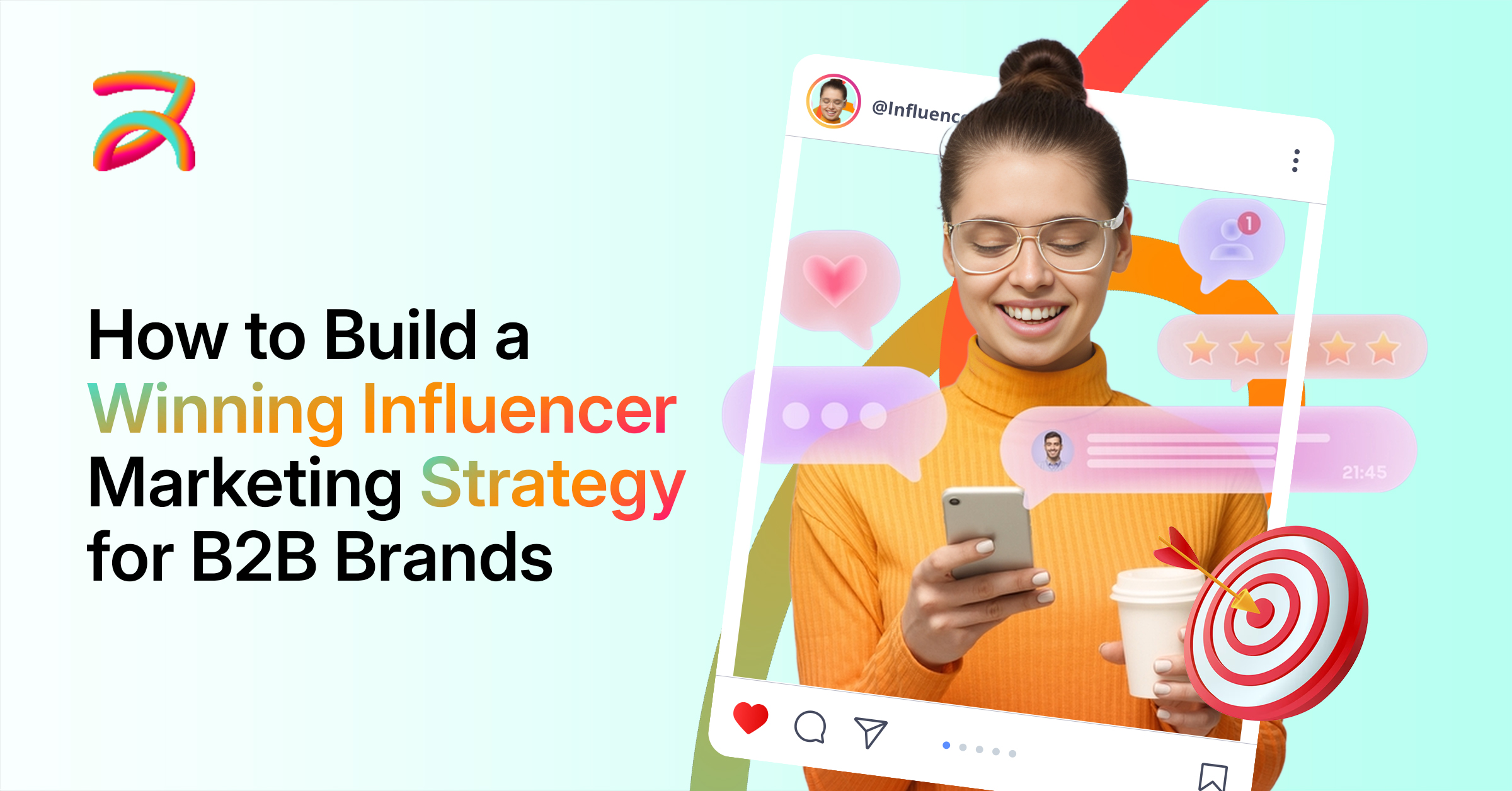Influencer marketing is no longer just a B2C playground, but B2B brands are starting to enter the game, and early results are encouraging.
Even a lot of organizations are still reluctant to get involved because they struggle to see how it fits into their longer sales cycles or more technical messaging, given the opportunity with an influencer marketing strategy.
Without a plan in place, it’s easy to network with the wrong people or pursue tactics that will yield little return. However, 93% of B2B marketers who have given this influencer marketing model a try have reported bigger reach and better trust.
These statistics show that influencer marketing can provide the same level of credibility and attention to value-based products as it has shown in consumer-based categories, if thought through appropriately.
In this blog, we’ll guide you through how to create a B2B influencer marketing strategy that can help you build trust, generate leads, and grow your business.
Let’s break the ice!
What Is B2B Influencer Marketing?
B2B influencer marketing links companies with expert voices that endorse products to other businesses. These specialists really know their field.
Years of insight and consistent content have earned them trust from executives who control budgets. Unlike consumer-focused campaigns, B2B influencers speak directly to professional crowds.
They reach CEOs, department heads, and frontline managers who choose services and tools. That targeted exposure pays off because firms value guidance from authorities they already respect.
When a well-known sector figure mentions your solution, followers pay attention. In business sales-especially slow-moving ones, that early credibility can move conversations forward.
Will Influencer Marketing Work for My B2B Brand?

Influencer marketing isn’t just for consumer-focused brands. B2B companies can benefit too, especially when they target the right influencers.
It’s about building trust and reaching decision-makers who influence purchasing decisions. Partnering with the right experts in your industry, you can boost brand credibility, expand your reach, and even generate high-quality leads.
But does it work for your brand?
Let’s debunk it.
Increased Trust and Social Proof in Complex Buying Cycles
When B2B teams shop for big-ticket items, the process musters a small crowd and stretches over several months. Because the budget being talked about is anything but small, stakeholders look for hard evidence before signing off.
Industry veterans give potential buyers that evidence by openly recounting how your solution delivered for them.
A glowing nod from a respected authority weighs far more than a banner in the trade press. People who follow that expert implicitly believe what they hear and pass that confidence along.
That wave of trust smooths over the natural wariness that large purchases and tangled approval routes usually stir.
Better Content Amplification vs. Brand-Only Messaging
Because influencers speak from actual experience, their content feels warmer and more credible than the polished voice of a corporate tagline.
Their shout-outs hit a different note and reach hearts as well as minds, forging a bond the firm’s own messaging struggles to match.
As a result, several B2B brands now report that campaigns powered by these voices routinely beat traditional efforts on both engagement numbers and how far the message spreads.
Here is a brief comparison of both methods:
| Metric | Influencer-Driven Content | Brand-Only Messaging |
| Engagement Rate | 3x higher engagement | Lower engagement |
| Audience Reach | Wider, more targeted | Narrower, less targeted |
| Trust Factor | Higher (due to influencer trust) | Lower (brand-driven) |
| Lead Generation | Higher quality leads | Lower quality leads |
| Content Authenticity | Higher (endorsed by an influencer) | Lower (self-promotion) |
Influencers as Subject-Matter Experts, Not Just Promoters
B2B influencers start out as trusted experts; promotion comes later. They earn respect by sharing useful advice and tackling everyday business challenges.
Their followers seek knowledge, not amusement. So, when a thought leader backs your product, they stake their reputation on it.
That endorsement matters a lot to business buyers who rely on outside judgment. Suddenly, your solution is seen as genuinely valuable, not just another pitch.
Long-Term Brand Equity and Pipeline Value
Influencer marketing in B2B aims at lasting ties, not fast transactions. Over time, these alliances boost credibility and keep prospects warm during slow sales cycles.
- Ongoing Brand Awareness: Influencers create constant exposure that nurtures trust over time.
- Qualified Leads: Influencer relationships attract leads who already trust your brand, making them more likely to convert.
- Sustained Credibility: Each content piece or recommendation from an influencer adds more value to your brand’s reputation.
- Long Sales Cycles: Influencer partnerships ensure that potential customers stay engaged throughout the entire decision-making process.
Key Differences Between B2B and B2C Influencer Marketing
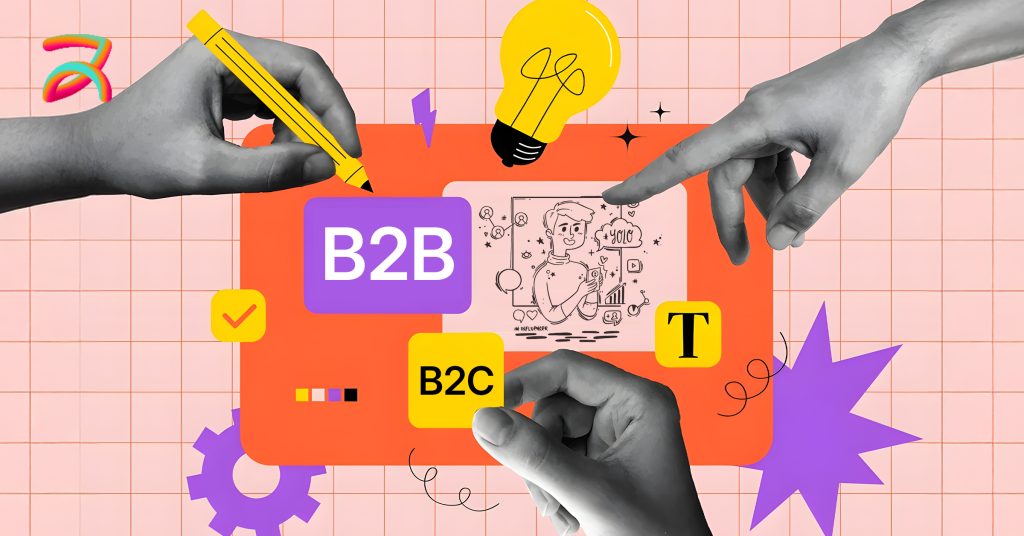
B2B and B2C influencer marketing are two different things because they target different audiences.
B2C is all about connecting with ordinary consumers, while B2B focuses on reaching business professionals. B2B influencers usually share industry tips and knowledge, while B2C influencers focus more on product reviews or lifestyle content.
Along with that, B2B sales take longer, so building trust and sharing useful info is key to winning over leads.
Influencers Type
B2C and B2B influencers create different types of content based on their target audience and industry.
Here’s a look at what each type of influencer focuses on:
B2C Influencers (Lifestyle Creators):
- Often work with consumer brands to promote products directly to followers.
- Create lifestyle content, such as fashion, beauty, or fitness posts.
- Focus on visually engaging content like photos and videos.
- Share personal stories and product experiences.
B2B Influencers (Industry Professionals/Subject-Matter Experts):
- Share valuable insights and expertise within their field.
- Focus on solving industry challenges and providing professional advice.
- Build authority and credibility by speaking at events or participating in interviews.
- Create educational content such as blogs, white papers, webinars, and case studies.
Audience Focus
B2C marketing targets emotions and personal desires. Influencers create content that makes people want products for lifestyle improvement or self-expression. B2B marketing focuses on rational business decisions.
The audience wants to see:
- Clear return on investment (ROI)
- Solutions to specific business problems
- Evidence from other successful companies
- Proof that products deliver measurable results
B2B buyers need logical reasons to justify purchases to their teams and budgets.
Sales Cycle
When you sell to consumers, the whole process usually unfolds in days or weeks. Shoppers spot an item, feel a spark of interest, and, more often than not, buy it without diving deep into reviews or needing a boss’s nod.
Business-to-business deals, by contrast, can drag on for months or even years. Every purchase gets poked and prodded by different teams that weigh options, stack up comparisons, and chase approvals across legal, finance, and IT departments.
B2B influencer marketing steps in along that lengthy route, gently feeding useful facts and answers at every fork in the road so prospects stay engaged and informed.
Content Format
Consumer-facing influencers lean on eye-catching, sometimes playful posts: think unboxing videos, polished lifestyle shots, or upbeat demos that make a product look irresistible.
Their job is to show how a purchase slips seamlessly into daily routines. By contrast, B2B voices craft material designed to help busy professionals untangle specific problems.
Webinars, real-world case studies, meaty industry reports, and timely thought pieces fill that pipeline. Rather than pure entertainment, this content serves up practical insights that the company can act on with confidence.
How to Identify the Right Influencers for Your B2B Brand
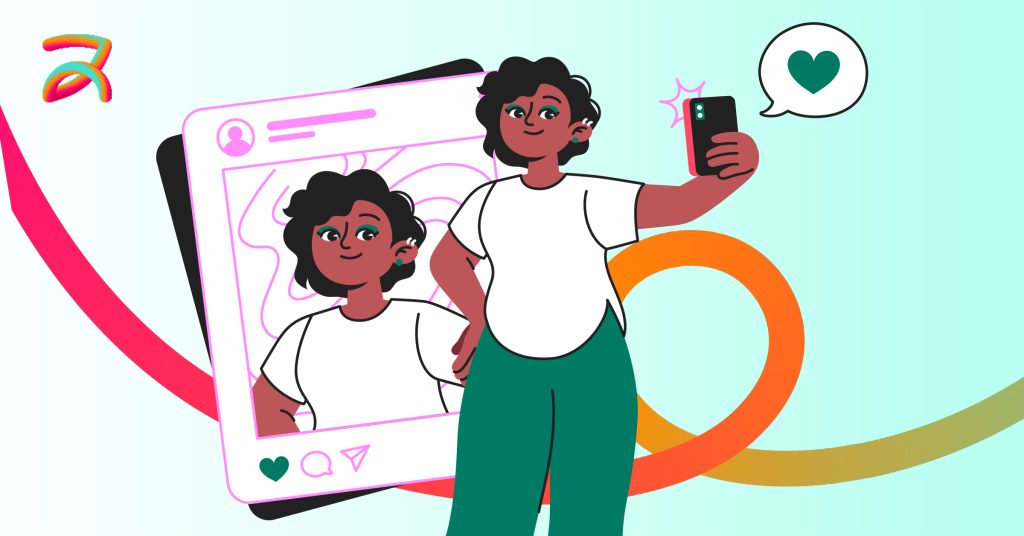
Connecting with the right B2B influencers needs a strategic approach. You need people who understand your industry and connect with your target audience very well. The best influencers aren’t always the ones with the most followers.
Focus on finding experts who share your values, speak to your ideal customers, and create content that aligns with your business goals.
Who Qualifies as a B2B Influencer?
B2B influencers are professionals who’ve built credibility and trust within specific industries. They share expert knowledge that helps other businesses make better decisions.
Key types of B2B influencers include:
- LinkedIn thought leaders are posting regularly about industry trends
- Conference speakers and podcast hosts with engaged audiences
- Industry experts and consultants who solve business problems
- Company founders and executives share leadership insights
- Software founders discussing technology and innovation
Use tools like BuzzSumo, LinkedIn search, and SparkToro to find potential influencers. Start with a broad list, then narrow it down based on relevance to your specific audience and goals.
Nano vs. Micro vs. Macro Influencers
B2B influencers fall into three main categories based on their follower count and reach within professional networks.
- Nano influencers (1K-10K followers): Highly engaged, niche audiences with strong personal connections
- Micro influencers (10K-100K followers): Good balance of reach and engagement, often specialists in specific areas
- Macro influencers (100K+ followers): Broad industry reach but potentially lower engagement rates
Nano influencers offer authentic connections and higher engagement. On the other hand, Micro-influencers provide targeted expertise with decent reach. Macro influencers deliver maximum visibility but may cost more and feel less personal to audiences.
Checklist for Evaluating Influencer Fit
Before partnering with any influencer, evaluate their alignment with your brand and goals. This assessment prevents mismatched partnerships that waste time and money.
Essential factors to check:
- Engagement quality: Are comments meaningful, not just likes and emojis?
- Audience relevance: Do their followers match your target customers?
- Content style: Does their communication match your brand voice?
- Brand alignment: Do their values match your company culture?
- Industry authority: Do peers respect and cite their opinions?
Use analytics tools to verify follower demographics and engagement rates before making partnership decisions.
📞 Take Your B2B Influencer Strategy to New Heights!
Book a strategy call with Buzzz today and discover how your B2B influencer program can drive faster growth and help you crush your marketing goals.
Book My Free Strategy Call →Types of B2B Influencer Content

B2B influencer content comes in several formats, and each one supports a different business aim. The strongest pieces educate while also demonstrating the unique value your brand brings to the table.
Some content types work better at specific stages of the buyer’s journey, so pick a format that matches both the influencer’s style and your audience’s preference. In most B2B environments, educational material tends to drive the best results.
Thought Leadership Interviews
Sit-down interviews with B2B influencers produce rich content that positions them as experts and links their authority directly to your brand.
These conversations unpack industry insights and emerging trends your audience cares about, keeping viewers informed and engaged. When well-respected voices speak through your channel, they lend credibility that rubs off on your business.
Followers of the guest see you as a connector of great minds, and that lift in perception can broaden your own community.
LinkedIn Carousel Collaborations
LinkedIn carousel posts let creators walk followers through a topic slide by slide. That visual stack is handy when explaining tough ideas, laying out step-by-step guides, or showing numbers a bit at a time.
Because everything stays on LinkedIn, professionals really sink their teeth into carousels, and they learn without hopping to another site.
By turning dense material into clear images and short phrases, influencers spark conversations that matter and invite more questions.
Twitter Threads with Strategic Commentary
Twitter threads give thought leaders space to unpack a subject across linked tweets without losing the crowd. Inside each post, they toss in data, stories, or quick tips that nudge followers to think, reply, and share.
Many winning campaigns open with a bold claim that sparks debate, pulling eyes and clicks as replies roll in. With every tweet promised next, readers stay hooked, eager to see the point that closes the chain.
Expert Blog Contributions
When a recognized voice pens a guest post, the author’s audience crosses over to your site, besides fresh, high-quality insights.
People often search for that name, so the piece picks up steady organic traffic long after publication day.
Besides Page views, the expert gives your brand a credibility boost, showing visitors you’re linked to trusted industry thinkers.
Podcast Appearances
Podcasts let influencers have long-form conversations about industry topics, sharing detailed insights that shorter content formats can’t accommodate.
B2B audiences often listen during commutes or while working, making podcasts perfect for busy professionals.
Guest appearances on established podcasts expose your brand to new audiences who already trust the host and regular content.
Collaborative Whitepapers
Working with influencers to create detailed research reports or guides produces high-value content that generates leads.
These comprehensive documents position both your brand and the influencer as industry authorities. Whitepapers work well as gated content, requiring email addresses for downloads.
This strategy builds your contact list while providing genuinely useful information that professionals can reference in their work.
Sponsored YouTube Tutorials
YouTube tutorials let influencers demonstrate their product or service in detail, showing real-world applications that help potential customers understand the value.
Video content builds stronger connections than text-based formats. Professional audiences appreciate detailed walkthroughs that help them evaluate whether your solution fits their needs.
Influencer-created tutorials feel more authentic than traditional product demos.
Setting Clear Goals for Your B2B Influencer Strategy

Clear goals guide your influencer marketing efforts and help measure success. Without specific objectives, you can’t determine if your campaigns work or waste money.
Your goals should align with broader business objectives and target specific outcomes. Different goals require different influencer types, content formats, and success metrics.
Top Goals for B2B Influencer Marketing
B2B influencer marketing serves several key business objectives that directly impact your bottom line and market position.
Primary goals include:
- Generate qualified leads: Attract potential customers who are more likely to convert because they trust the recommending influencer
- Increase brand credibility and authority: Position your company as a trusted industry leader through expert endorsements
- Strengthen client relationships: Build deeper trust with existing customers through continued expert association
- Accelerate sales funnel conversion: Move prospects through decision stages faster with third-party validation
- Expand market reach: Access new professional networks through influencer audiences
Aligning Goals with KPIs
Measuring influencer marketing success requires tracking specific metrics that connect to your business goals. Different objectives need different measurement approaches to show real impact.
Expert Tip: “Match your KPIs to goals: awareness campaigns focus on impressions and reach, engagement campaigns track clicks and comments, while lead generation measures conversions and sales.”
Use Google Analytics to track website traffic from influencer content, LinkedIn Insights for professional engagement data, and HubSpot to monitor lead quality and conversion rates.
Set baseline numbers before campaigns start, then compare results to show clear ROI.
Choosing the Right Platforms for B2B Influencer Marketing
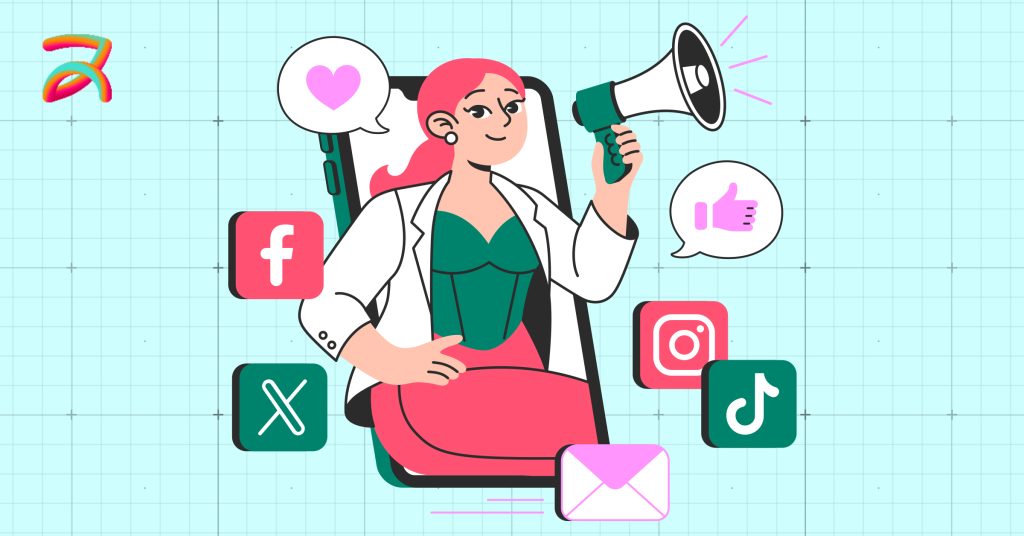
Picking the right platform is key for B2B influencer marketing. LinkedIn is great for reaching professionals, while Twitter can be useful for industry discussions.
YouTube and blogs also work well for sharing educational content. The goal is to choose platforms where your target audience is most active.
LinkedIn: #1 for B2B Credibility and Thought Leadership
LinkedIn dominates B2B influencer marketing because decision-makers actively use it for professional networking and industry insights.
The platform’s business-focused environment makes it perfect for sharing expert opinions and building credibility. Work with LinkedIn influencers to create thought leadership posts, share case studies, and participate in industry discussions.
Their professional networks trust their recommendations, making LinkedIn endorsements especially valuable for B2B brands seeking credibility.
Twitter/X: Ideal for Tech and SaaS Thought Leadership
Twitter connects you with tech professionals, startup founders, and industry innovators who shape technology trends.
The platform’s real-time nature makes it perfect for sharing quick insights and joining industry conversations.
Use Twitter influencers to promote valuable content like blog posts, whitepapers, and industry commentary.
Their followers expect frequent, bite-sized insights that help them stay current with rapidly changing technology landscapes and business strategies.
YouTube: Deep-Dive Explainers, Webinars, and Product Tutorials
YouTube’s video format allows for detailed explanations that text-based content can’t match.
B2B audiences appreciate comprehensive tutorials and demonstrations that help them understand complex products or services before making purchasing decisions.
Partner with YouTube influencers to create product demos, step-by-step tutorials, and customer success stories.
Video content builds stronger connections and trust because viewers can see real people explaining real solutions to business problems.
Podcasts: Reaching Executive Audiences and Niche Topics
Busy executives and professionals often consume podcast content during commutes or while multitasking.
This makes podcasts an excellent way to reach decision-makers who might not engage with other content formats. Collaborate with podcast hosts to discuss industry trends, share expertise, and build relationships with niche audiences.
Long-form conversations allow for deeper discussions that build trust and showcase your brand’s knowledge more effectively than shorter content formats.
Medium/Substack: Written Insights from Trusted Creators
Medium and Substack attract readers seeking in-depth analysis and thoughtful commentary on business topics.
These platforms position writers as serious thought leaders rather than casual content creators.
Work with influencers;
- To publish guest articles
- Detailed case studies
- Industry insights on these platforms
Their existing readership trusts their expertise, making written recommendations particularly powerful for complex B2B solutions that require detailed explanation and consideration.
Each Platform & Effectiveness on B2B Influencer Marketing
Every platform has its unique opportunities for B2B influencer marketing.
Here’s a comparison of the best platforms for reaching your target audience and using influencer partnerships.
| Platform | Why it’s Crucial for B2B Brands | Tips for Using Influencers |
| LinkedIn: #1 for B2B Credibility and Thought Leadership | Professional audience, industry experts, and content sharing | Use LinkedIn influencers for thought leadership and case studies |
| Twitter/X: Ideal for Tech and SaaS Thought Leadership | Great for connecting with tech professionals and expanding into niche markets | Promote valuable content like blogs, white papers, and industry commentary |
| YouTube: Deep-Dive Explainers, Webinars, and Product Tutorials | Highly engaging platform for demos, tutorials, and customer testimonials | Use YouTube influencers for product demos and tutorials |
| Podcasts: Reaching Executive Audiences and Niche Topics | Excellent for thought leadership and niche topics, reaching decision-makers | Collaborate with podcast hosts to reach executive decision-makers |
| Medium/Substack: Written Insights from Trusted Creators | Powerful for written content, guest blogs, articles, and thought leadership | Partner with influencers for guest posts, articles, and thought leadership pieces |
Building a B2B Influencer Campaign (Step-by-Step)
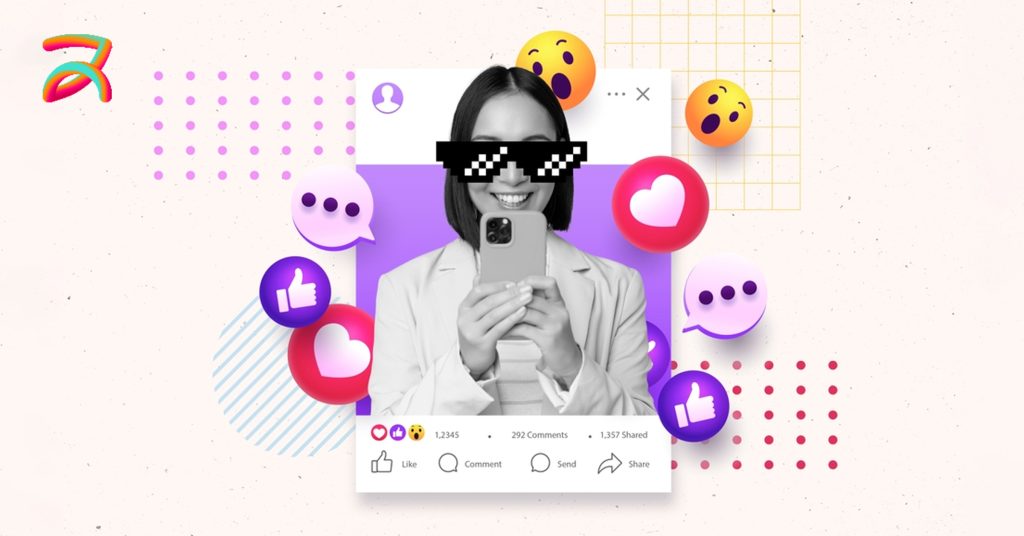
Creating a successful B2B influencer campaign requires a clear plan and thoughtful execution.
Start by defining your goals, identifying the right influencers, and crafting content that resonates with your target audience.
From there, amplify your content across the right platforms and measure your campaign’s effectiveness to ensure you’re hitting your business objectives.
Research and Shortlist Influencers
Finding the right influencers requires systematic research and careful evaluation. Start by identifying experts who already discuss topics related to your industry and solutions.
Key steps for influencer research:
- Use LinkedIn to search for industry professionals with engaged followings
- Check BuzzSumo and SparkToro to find content creators in your niche
- Create a shortlist of 10-15 potential partners before reaching out
- Look for speakers at industry conferences and podcast guests
- Verify their expertise matches your target customer’s needs
- Evaluate their audience quality, not just follower count
Outreach & Relationship Building
Successful influencer outreach requires personalized communication that shows you understand their work and audience.
Generic pitches get ignored, while thoughtful messages build genuine partnerships. Start with personalized emails that reference their recent content and explain how collaboration benefits their audience.
Be transparent about expectations, timelines, and compensation. Focus on building long-term relationships rather than one-off promotions.
Long-term partnerships create more authentic content and better results than transactional arrangements.
Co-Create Content
Collaborative content creation ensures the final product feels authentic to the influencer’s voice while meeting your marketing goals.
The best B2B influencer content educates audiences while naturally showcasing your brand’s value.
Work together on blog posts, webinars, case studies, podcasts, panel discussions, and product walkthroughs.
Give influencers creative freedom while providing key messages and brand guidelines.
Involve them in planning stages to ensure content resonates with their audience and aligns with their typical content style.
Launch Campaign & Promote Across Channels
Maximize your influencer content’s reach by promoting it across multiple channels.
Don’t rely solely on the influencer’s audience to discover and engage with the content.
Campaign promotion strategy:
- Share influencer content on your company’s social media accounts
- Ensure influencers actively promote the content on their channels
- Cross-promote on relevant industry forums and communities
- Use paid promotion to boost reach when appropriate
- Feature it in email newsletters to your subscriber list
- Publish it on your blog or website for SEO benefits
Measure & Optimize Performance
Track specific metrics that align with your campaign goals to understand what works and what needs improvement.
Regular measurement helps optimize future campaigns and justify influencer marketing investments. Monitor engagement metrics like comments and shares, lead generation through tracking links and forms, and sales metrics to calculate ROI.
Analyze results monthly and adjust strategies based on performance patterns.
Expert Tip: Use Google Analytics to track website traffic from influencer content, HubSpot for lead scoring and conversion tracking, and LinkedIn Insights for professional engagement data.
Metrics That Matter in B2B Influencer Marketing

To measure the success of your B2B influencer marketing, focus on key metrics like engagement rate, lead generation, website traffic, and conversion rates.
These indicators show how well your campaign connects with the target audience, builds trust, and drives real business results.
Tracking these metrics helps refine your strategy and improve future campaigns.
Reach: Views and Impressions
Reach measures how many people see your influencer content across different platforms. This metric shows your campaign’s visibility and brand awareness potential within your target market.
Track views on video content, impressions on social media posts, and unique visitors to blog articles. Platform analytics provides these numbers automatically.
Higher reach means more professionals learn about your brand, but reach alone doesn’t guarantee business results without engagement and conversions.
Engagement: Shares, Comments, and Clicks
Engagement shows how actively audiences interact with your influencer content.
High engagement indicates the content resonates with viewers and sparks meaningful conversations about your brand.
Key engagement metrics to monitor:
- Click-through rates on links directing traffic to your website
- Saves and bookmarks indicating content provide lasting value
- Direct messages or connection requests generated by the content
- Shares that expand your content’s reach to new professional networks
- Comments that show genuine interest or ask questions about your solution
Influence: Demo Requests, Inbound Mentions
Influence metrics demonstrate your campaign’s ability to drive specific business actions. These measurements show whether influencer content motivates people to take the next step in your sales process.
Track demo requests that mention the influencer or campaign, inbound inquiries referencing the content, and branded searches that increase after campaign launch.
Monitor social media mentions of your brand following influencer posts. These actions indicate genuine interest from qualified prospects who trust the influencer’s recommendation.
Attribution: Sourced Pipeline, Lead Quality, Opportunity Conversion
Attribution connects influencer marketing activities to actual sales results and revenue generation. This data proves the real business value of your influencer investments beyond vanity metrics.
Use tools like HubSpot, Salesforce, or Google Analytics to track leads from influencer content through your sales pipeline.
Expert Tip: Monitor lead quality scores, conversion rates from marketing qualified leads to sales qualified leads, and final deal closure rates.
Calculate customer acquisition costs and lifetime value to determine true ROI from influencer partnerships.
Common B2B Influencer Strategy Mistakes To Avoid

Many B2B brands make mistakes like choosing influencers based solely on follower count or failing to define clear goals.
It’s important to ensure the influencer’s audience aligns with your target market. Additionally, not measuring campaign performance or neglecting authenticity can hurt your brand’s reputation.
Avoid these mistakes for a more effective influencer marketing strategy.
Choosing Influencers Based Only on Vanity Metrics
Follower count doesn’t guarantee business results in B2B marketing. An influencer with 100,000 followers might generate fewer qualified leads than someone with 5,000 engaged industry professionals.
Focus on metrics that matter for business growth:
- Comments demonstrating thoughtful discussion about industry topics
- Track record of driving actual business outcomes for other brands
- Engagement rates showing genuine interaction, not just likes
- Authority and respect within your specific industry niche
- Audience quality and relevance to your target market
Failing to Align Influencer Voice with Brand Tone
Mismatched messaging confuses audiences and weakens your brand’s credibility.
When an influencer’s communication style clashes with your brand voice, the partnership feels forced and inauthentic to professional audiences.
Review potential influencers’ content carefully before partnering. Their typical tone, values, and messaging approach should complement your brand personality.
Provide clear brand guidelines while allowing creative freedom. The goal is natural integration, not scripted promotion that feels out of character for the influencer.
Treating It Like a One-Off B2C Promotion
B2B influencer marketing requires sustained effort and relationship building. Single promotional posts rarely generate meaningful results because business decision-makers need multiple touchpoints and ongoing trust-building before making purchasing decisions.
Develop long-term partnerships that create consistent value over months or years. One-off campaigns miss opportunities to nurture prospects through complex sales cycles.
Consistent influencer collaboration builds stronger brand association and deeper trust with professional audiences who make careful, researched buying decisions.
Not Integrating Into Sales and Content Funnel
Disconnected influencer campaigns waste opportunities to convert interest into actual business results.
When influencer content doesn’t align with your sales process, potential leads fall through the cracks without proper follow-up.
Essential integration strategies to integrate:
- Train sales teams to recognize and prioritize influencer-generated leads.
- Use tracking systems that connect influencer activities to sales outcomes.
- Create landing pages specifically for influencer traffic with relevant offers.
- Coordinate timing between influencer content and sales team outreach efforts.
- Develop content that guides prospects through each stage of your sales funnel.
Real B2B Influencer Marketing Examples
Learning from successful B2B influencer campaigns helps you understand what works in real business situations. These examples show how major companies use influencer partnerships to achieve specific marketing goals.
Each case demonstrates different approaches, platforms, and content types that deliver measurable results for B2B brands across various industries.
Salesforce: Partnering with Tech Influencers for Dreamforce Content
Salesforce amplifies its annual Dreamforce conference by partnering with technology influencers who attend and create content around the event.
These partnerships extend the conference’s reach far beyond physical attendees.
Tech influencers share live updates, interview speakers, and provide behind-the-scenes content that generates excitement for future events.
Their authentic experiences help Salesforce showcase the conference’s value while building anticipation among professionals who couldn’t attend.
This strategy transforms a single event into year-round marketing content.
HubSpot: Using YouTube Creators for Tutorials and Thought Leadership
HubSpot partners with marketing and sales professionals on YouTube to create educational content that teaches viewers how to use their platform effectively.
These tutorials feel more authentic than traditional product demos because they come from real users.
YouTube creators demonstrate HubSpot features while sharing their own marketing insights and strategies. This approach builds trust because viewers learn from peers rather than salespeople.
The educational content drives organic traffic and positions HubSpot as the preferred solution for marketing professionals seeking growth.
Monday.com: Collaborating with LinkedIn Creators for Workflow Content
Monday.com works with productivity and project management influencers on LinkedIn to showcase how their platform solves real workplace challenges.
These creators share workflow tips and organizational strategies that naturally incorporate Monday.com features.
LinkedIn’s professional audience connects with content about improving work efficiency and team collaboration.
Influencer partnerships help Monday.com reach decision-makers who actively seek solutions for project management challenges.
The platform’s visual nature makes it perfect for demonstrating workflow improvements through influencer content.
Adobe: Partnering with Creative Professionals Across Platforms
Adobe collaborates with designers, photographers, and creative professionals across multiple platforms to showcase their creative tools in action.
These partnerships demonstrate real-world applications rather than theoretical features.
Creative influencers produce stunning work using Adobe products, inspiring their audiences while subtly promoting the tool’s capabilities. This approach targets both individual creators and businesses that need creative solutions.
Adobe’s influencer strategy spans YouTube tutorials, Instagram showcases, and LinkedIn thought leadership from creative industry experts.
Final Thoughts
B2B influencer marketing needs strategic planning, influencer selection, and relationship management to see results.
Many brands struggle with finding the right experts, creating authentic partnerships, and measuring ROI.
Working with a professional influencer marketing agency solves these challenges by offering vetted influencers, proven strategies, and performance tracking, ensuring your campaigns align with goals and generate qualified leads.
🎯 Ready to Launch Your B2B Influencer Program?
Book a strategy call with Buzzz today to launch your B2B influencer program and accelerate your marketing goals.
Book Your Strategy Call →Top 10 FAQs for B2B Influencer Marketing
What is B2B influencer marketing?
B2B influencer marketing involves partnering with industry experts or thought leaders to promote your brand’s products or services. Unlike B2C marketing, which focuses on consumers, B2B influencer marketing targets business professionals, decision-makers, and organizations. It builds trust, expands reach, and generates leads by leveraging the credibility of influencers in your industry.
Does influencer marketing work for B2B brands?
Yes, influencer marketing can work for B2B brands. In fact, 93% of B2B marketers say it helps them expand their reach and establish trust. By collaborating with industry experts, B2B brands can connect with the right decision-makers, nurture relationships, and boost credibility, making it an effective tool for long-term business growth.
How do I find B2B influencers?
To find B2B influencers, start by looking for professionals with a strong presence in your industry on platforms like LinkedIn, Twitter, and niche forums. Look for individuals who have a deep understanding of your sector, engage with your target audience, and have a track record of creating valuable content. Tools like BuzzSumo or Upfluence can also help in identifying influencers.
What platforms are best for B2B influencer marketing?
- LinkedIn: Best for reaching business professionals and decision-makers.
- Twitter: Ideal for tech, SaaS, and niche B2B industries.
- YouTube: Great for product demos, tutorials, and educational content.
- Podcasts: Effective for reaching executive-level decision-makers and discussing niche topics.
- Medium/Substack: Powerful for sharing written insights and thought leadership articles.
How do I measure ROI from B2B influencer campaigns?
To measure ROI, track metrics like engagement (likes, shares, comments), lead generation (form submissions, sign-ups), website traffic (from influencer content), and conversion rates (how many leads turn into customers). Use tools like Google Analytics, LinkedIn Insights, and CRM systems to attribute results to your influencer campaigns.
What content works best in B2B influencer marketing?
- The best content in B2B influencer marketing includes:
- Educational content: Blog posts, whitepapers, and case studies.
- Webinars and podcasts: Industry insights and discussions.
- Product demos and tutorials: Showcasing how your product or service solves problems.
- Thought leadership articles: Sharing expertise and opinions on industry trends.
How much do B2B influencers charge?
B2B influencer fees vary based on factors like follower count, engagement, and the platform used. Micro-influencers typically charge between $1,000 $5,000 per post, while more established influencers or thought leaders may charge $10,000 or more per collaboration. It’s essential to align costs with your campaign’s goals and target audience.
What are common B2B influencer marketing mistakes?
Common mistakes include:
- Focusing only on follower count instead of audience relevance.
- Not setting clear campaign goals.
- Failing to measure performance and optimize campaigns.
- Choosing influencers who don’t align with your brand values or audience.
- Overlooking authenticity in influencer partnerships.
Should I use micro or macro influencers for B2B?
It depends on your campaign goals. Micro-influencers tend to have more engaged, niche audiences, which can lead to higher-quality leads and better conversions. Macro-influencers, on the other hand, offer a broader reach. For B2B, micro-influencers are often more effective in establishing trust and generating meaningful connections.
Can employees be influencers in B2B?
Yes, employees can be powerful influencers in B2B marketing. Employee advocacy, where employees share their expertise and promote the brand, helps build credibility and trust. Since employees are already trusted by their networks, they can effectively spread the message about your company’s values, products, and services.


